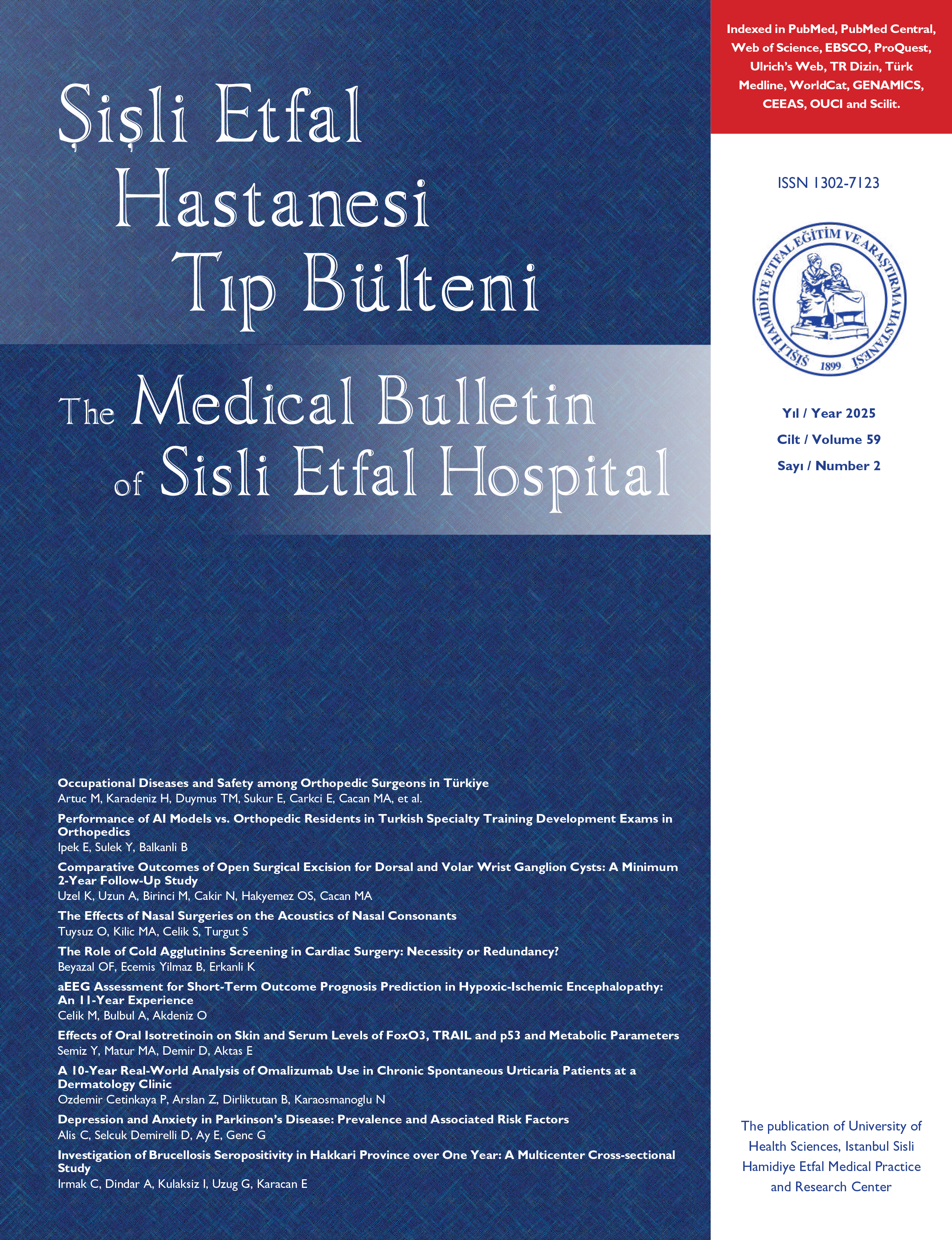
Adolescents and anemia
Seda Ocak1, Önder Kılıçaslan2, Zeynep Yıldız Yıldırmak3, Nafiye Urgancı41Koç Üniversitesi Hastanesi, Çocuk Sağlığı ve Hastalıkları Bölümü, İstanbul - Türkiye2Düzce Üniversitesi, Tıp Fakultesi, Çocuk Acil Bilim Dalı, Düzce- Türkiye
3Sağlık Bilimleri Üniversitesi, Şişli Hamidiye Etfal Araştırma ve Uygulama Merkezi, Çocuk Hematoloji Bilim Dalı, İstanbul - Türkiye
4Sağlık Bilimleri Üniversitesi, Şişli Hamidiye Etfal Araştırma ve Uygulama Merkezi, Çocuk Gastroenteroloji Bilim Dalı, İstanbul - Türkiye
Objective: Anemia in adolescents is a significant health problem caused by multiple factors. With this study, we aimed to investigate anemia aetiology and its frequency among the adolescents.
Material and Method: A total of 74 patients were admitted to Pediatrics Clinic of Istanbul Şişli Hamidiye Etfal Training and Research Hospital between January 2012 and August 2013, who were aged between 10-19 years and diagnosed with anemia, were investigated regarding the aetiology.
Results: Female and male ratio were 74.3% and 25.7%, respectively, and the mean age of the patients was 14.7±1.8 years. The most common symptom was fatigue. Red meat consumption was detected to be low in patients who were diagnosed with iron deficiency anemia (IDA). Six of the patients had a history of bleeding. Menorrhagia was present in 23.6% of the females. As a result of certain laboratory tests, 81.1% of the patients were diagnosed with IDA. The aetiological evaluation revealed that the most common reason for the anemia was nutritional. Vitamin B12 deficiency and folic acid deficiency anemia were diagnosed in 13.5% and 1.4% of patients, respectively. Eleven patients underwent endoscopy, and the most common finding was gastritis. Apart from these diagnosis, we reported acute leukaemia in 3 patients, sepsis in 3 patients, hereditary spherocytosis, autoimmune hepatitis, autoimmune hemolytic anemia, aplastic anemia, a chronic renal failure and cholangitis in one patient each. While 39.2% of the patients were treated with hospitalization, 60.8% of the patients were under outpatient follow-up and treated.
Conclusion: An inappropriate diet and eating habit is the most common aetiology of anemia among the adolescents. Considering that this age group of patients are not under routine health care followup of pediatricians, it is necessary to examine the adolescent for anemia for early diagnosis, with investigating the causes and selecting the appropriate treatment.
Adolesanlar ve anemi
Seda Ocak1, Önder Kılıçaslan2, Zeynep Yıldız Yıldırmak3, Nafiye Urgancı41Koç Üniversitesi Hastanesi, Çocuk Sağlığı ve Hastalıkları Bölümü, İstanbul - Türkiye2Düzce Üniversitesi, Tıp Fakultesi, Çocuk Acil Bilim Dalı, Düzce- Türkiye
3Sağlık Bilimleri Üniversitesi, Şişli Hamidiye Etfal Araştırma ve Uygulama Merkezi, Çocuk Hematoloji Bilim Dalı, İstanbul - Türkiye
4Sağlık Bilimleri Üniversitesi, Şişli Hamidiye Etfal Araştırma ve Uygulama Merkezi, Çocuk Gastroenteroloji Bilim Dalı, İstanbul - Türkiye
Amaç: Adolesan dönemde anemi birçok faktöre bağlı olarak gelişebilen ciddi bir sağlık sorunudur. Bu çalışmada; adolesan dönemde anemileri araştırarak etiyolojide yer alan hastalıkları gözden geçirmeyi ve bu hastalıkların sıklığını tartışmayı amaçladık.
Gereç ve Yöntem: İstanbul Şişli Hamidiye Etfal Eğitim ve Araştırma Hastanesi Çocuk Sağlığı ve Hastalıkları Kliniğine bağlı servis ve polikliniklerde Ocak 2012-Ağustos 2013 tarihleri arasında 10-19 yaş arası anemi tespit edilen 74 hastanın etiyolojik yönden araştırması yapıldı.
Bulgular: Hastaların %74.3ü kız, %25.7si erkekti ve yaş ortalaması 14.7±1.8 idi. En sık şikayet halsizlikti. Demir eksikliği tanısı alan hastalarda kırmızı et tüketiminin az olduğu tespit edildi. Kanama öykü- sü 6 hastada vardı. Kız cinsiyetteki hastaların %23.6sında menoraji mevcuttu. Yapılan laboratuar tetkikleri sonucunda hastaların %81.1ine demir eksikliği anemisi tanısı kondu. Etiyolojik araştırmada konulan tanılar arasında en sık olanı nütrisyonel demir eksikliği oldu. Hastaların %13.5inde B12 eksikliği tespit edilirken, %1.4ünde folik asit eksikliği saptandı. Endoskopi 11 hastaya yapıldı ve en sık gastrit saptandı. Bu tanılar dışında 3 hasta akut lösemi, 3 hasta sepsis, 1 hasta herediter sferositoz, 1 hasta otoimmun hepatit, 1 hasta otoimmun hemolitik anemi, 1 hasta aplastik anemi, 1 hasta kronik böbrek yetmezliği, 1 hasta kolanjit tanısı aldı. Hastaların %39.2si servise yatırılarak tedavi edilirken %60.8i ayaktan takip ve tedaviye alındı.
Sonuç: Adolesan döneminde anemi nedenlerinin başında sağlıksız beslenme gelmektedir. Çocuk hekimleri olarak bize nadiren başvuran bu yaş grubunda sağlık takiplerini düzenli yapmak, sağlık sorunlarını erken tespit edip nedenlerine yönelik araştırmayı ve uygun tedaviyi yapabilmek gerekir.
Manuscript Language: Turkish



















